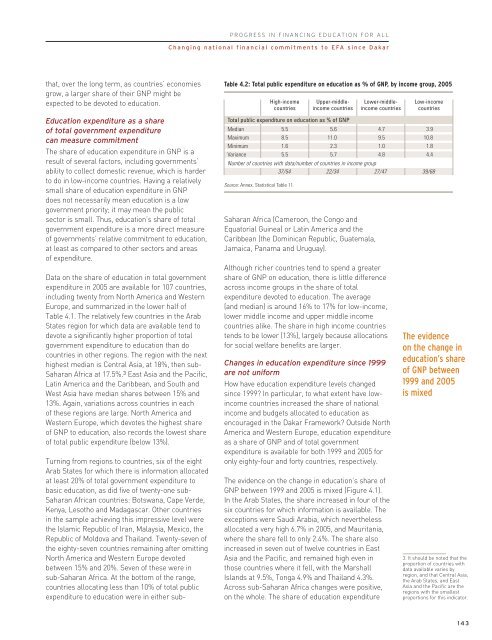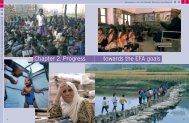Financing Education / pdf - Unesco
Financing Education / pdf - Unesco
Financing Education / pdf - Unesco
Create successful ePaper yourself
Turn your PDF publications into a flip-book with our unique Google optimized e-Paper software.
PROGRESS IN FINANCING EDUCATION FOR ALL<br />
Changing national financial commitments to EFA since Dakar<br />
that, over the long term, as countries’ economies<br />
grow, a larger share of their GNP might be<br />
expected to be devoted to education.<br />
<strong>Education</strong> expenditure as a share<br />
of total government expenditure<br />
can measure commitment<br />
The share of education expenditure in GNP is a<br />
result of several factors, including governments’<br />
ability to collect domestic revenue, which is harder<br />
to do in low-income countries. Having a relatively<br />
small share of education expenditure in GNP<br />
does not necessarily mean education is a low<br />
government priority; it may mean the public<br />
sector is small. Thus, education’s share of total<br />
government expenditure is a more direct measure<br />
of governments’ relative commitment to education,<br />
at least as compared to other sectors and areas<br />
of expenditure.<br />
Data on the share of education in total government<br />
expenditure in 2005 are available for 107 countries,<br />
including twenty from North America and Western<br />
Europe, and summarized in the lower half of<br />
Table 4.1. The relatively few countries in the Arab<br />
States region for which data are available tend to<br />
devote a significantly higher proportion of total<br />
government expenditure to education than do<br />
countries in other regions. The region with the next<br />
highest median is Central Asia, at 18%, then sub-<br />
Saharan Africa at 17.5%. 3 East Asia and the Pacific,<br />
Latin America and the Caribbean, and South and<br />
West Asia have median shares between 15% and<br />
13%. Again, variations across countries in each<br />
of these regions are large. North America and<br />
Western Europe, which devotes the highest share<br />
of GNP to education, also records the lowest share<br />
of total public expenditure (below 13%).<br />
Turning from regions to countries, six of the eight<br />
Arab States for which there is information allocated<br />
at least 20% of total government expenditure to<br />
basic education, as did five of twenty-one sub-<br />
Saharan African countries: Botswana, Cape Verde,<br />
Kenya, Lesotho and Madagascar. Other countries<br />
in the sample achieving this impressive level were<br />
the Islamic Republic of Iran, Malaysia, Mexico, the<br />
Republic of Moldova and Thailand. Twenty-seven of<br />
the eighty-seven countries remaining after omitting<br />
North America and Western Europe devoted<br />
between 15% and 20%. Seven of these were in<br />
sub-Saharan Africa. At the bottom of the range,<br />
countries allocating less than 10% of total public<br />
expenditure to education were in either sub-<br />
Table 4.2: Total public expenditure on education as % of GNP, by income group, 2005<br />
Median<br />
Maximum<br />
Minimum<br />
Variance<br />
High-income<br />
countries<br />
Upper-middleincome<br />
countries<br />
Total public expenditure on education as % of GNP<br />
5.5 5.6 4.7 3.9<br />
8.5 11.0 9.5 10.8<br />
1.6 2.3 1.0 1.8<br />
5.5 5.7 4.8 4.4<br />
Number of countries with data/number of countries in income group<br />
37/54 22/34 27/47 39/68<br />
Source: Annex, Statistical Table 11.<br />
Saharan Africa (Cameroon, the Congo and<br />
Equatorial Guinea) or Latin America and the<br />
Caribbean (the Dominican Republic, Guatemala,<br />
Jamaica, Panama and Uruguay).<br />
Lower-middleincome<br />
countries<br />
Although richer countries tend to spend a greater<br />
share of GNP on education, there is little difference<br />
across income groups in the share of total<br />
expenditure devoted to education. The average<br />
(and median) is around 16% to 17% for low-income,<br />
lower middle income and upper middle income<br />
countries alike. The share in high income countries<br />
tends to be lower (13%), largely because allocations<br />
for social welfare benefits are larger.<br />
Changes in education expenditure since 1999<br />
are not uniform<br />
How have education expenditure levels changed<br />
since 1999? In particular, to what extent have lowincome<br />
countries increased the share of national<br />
income and budgets allocated to education as<br />
encouraged in the Dakar Framework? Outside North<br />
America and Western Europe, education expenditure<br />
as a share of GNP and of total government<br />
expenditure is available for both 1999 and 2005 for<br />
only eighty-four and forty countries, respectively.<br />
The evidence on the change in education’s share of<br />
GNP between 1999 and 2005 is mixed (Figure 4.1).<br />
In the Arab States, the share increased in four of the<br />
six countries for which information is available. The<br />
exceptions were Saudi Arabia, which nevertheless<br />
allocated a very high 6.7% in 2005, and Mauritania,<br />
where the share fell to only 2.4%. The share also<br />
increased in seven out of twelve countries in East<br />
Asia and the Pacific, and remained high even in<br />
those countries where it fell, with the Marshall<br />
Islands at 9.5%, Tonga 4.9% and Thailand 4.3%.<br />
Across sub-Saharan Africa changes were positive,<br />
on the whole. The share of education expenditure<br />
Low-income<br />
countries<br />
The evidence<br />
on the change in<br />
education’s share<br />
of GNP between<br />
1999 and 2005<br />
is mixed<br />
3. It should be noted that the<br />
proportion of countries with<br />
data available varies by<br />
region, and that Central Asia,<br />
the Arab States, and East<br />
Asia and the Pacific are the<br />
regions with the smallest<br />
proportions for this indicator.<br />
143

















